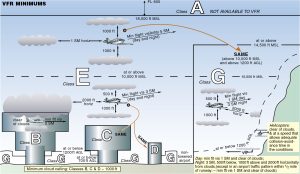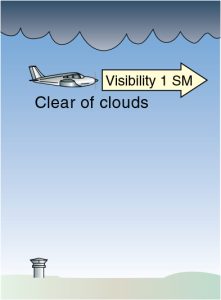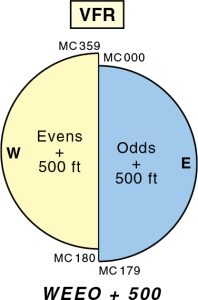This week we’ll expand on what we’ve discussed about regulations. Chapter 19 in the brand-new fourth edition of The Pilot’s Manual: Ground School has a great overview of the FARs you’ll need to know. Beyond that, of course, is our FAR/AIM; the complete up-to-date set of aviation regulations. Today, we’ll feature an excerpt from the fourth edition of the PM-2C.
Basic VFR Weather Minimums
The basic weather minimums required for you to fly VFR are stated in terms of flight visibility and distance from clouds (horizontally and vertically). For VFR operations within Class B, C, D and E surface areas around airports with an operating control tower, you require:
- cloud ceiling at least 1,000 feet AGL; and
- ground visibility at least 3 statute miles (usually measured by ATC but, if not available, flight visibility at least 3 statute miles as estimated by the pilot).
This can seem very confusing and not just to the beginning pilot. Yet it really is pretty simple for most general aviation pilots, because below 10,000 feet, the following rules comply with all airspace ceiling and visibility requirements—maintain 3 SM visibility:
- 500 feet below clouds;
- 1,000 feet above clouds; and
- at least 2,000 feet lateral separation from the clouds.


The requirements are slightly less restrictive in Class G airspace, with a less restrictive daytime visibility below 10,000 feet MSL (1 statute mile only) and, below 1,200 feet AGL by day a less-restrictive separation from clouds (clear of clouds, with no distance-from-cloud requirements). In Class B airspace aircraft are required to remain clear of clouds. In Class C, D, E and at night, Class G airspace, aircraft are required to maintain a minimum distance of 1,000 feet above, 500 feet below and 2,000 feet horizontal from clouds. Also, in Class G airspace, when the visibility is less than 3 statute miles but not less than 1 statute mile during night hours, an airplane may be operated clear of clouds if operated in an airport traffic pattern within one-half mile of the runway.
Special VFR Weather Minimums
A pilot operating below 10,000 feet MSL in or above the airspace designated on the surface for an airport may be issued an ATC clearance to operate under special VFR, which reduces the normal requirements down to:
- flight visibility 1 statute mile (and ground visibility 1 statute mile for takeoff and landing); and
- clear of clouds.
To take off or land at any airport in Class B, C, D and E airspace under special VFR, the ground visibility at the airport must be at least 1 statute mile. If ground visibility is not reported, then the flight visibility during takeoff or landing must be at least 1 statute mile. A noninstrument-rated pilot may be issued a special VFR clearance by day but, to operate under special VFR at night, you must be instrumentrated, instrument-current and flying in an IFR-equipped airplane.

ATC may issue a special VFR clearance
Airports in Class B, C or D airspace have a control tower from which you can request a special-VFR clearance. Airports in Class E airspace do not have a control tower, but your request for special VFR can be relayed via Flight Service Station to the ATC facility responsible for that Class E airspace (only ATC, and not a Flight Service Station, can issue an ATC clearance, although a Flight Service Station may relay it to you). Special VFR is prohibited at some airports (see 14 CFR, Part 91).
VFR Cruise Altitude or Flight Level
VFR cruise altitudes or flight levels, when more than 3,000 feet AGL, are:
- on a magnetic course of magnetic north to magnetic 179: odds+500 feet—for example, 3,500 feet MSL, 15,500 feet MSL; and
- on a magnetic course of magnetic 180 to magnetic 359: evens+500 feet—for example, 4,500 feet MSL, 16,500 feet MSL.
(You can memorize this as “West Evens, East Odds, plus 500 feet,” or “WEEO+500.”)

VFR cruise altitudes and flight levels above 3,000 feet AGL.





